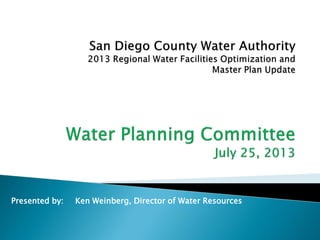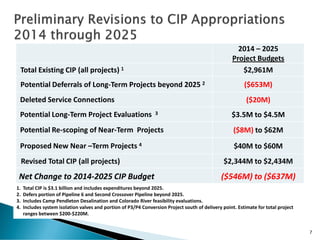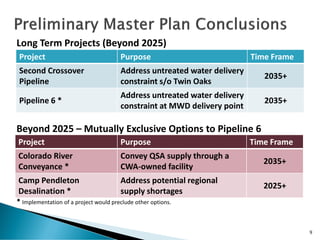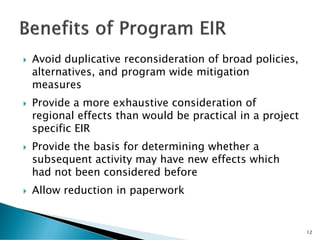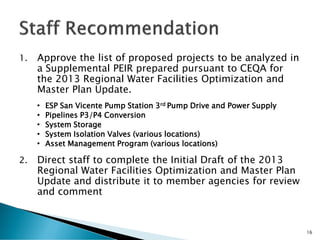Master Plan
- 1. Presented by: Ken Weinberg, Director of Water Resources
- 2. Supply/Demand Analysis and Scenario Planning Evaluation Thresholds and Decision Metrics Baseline System Performance Storage Utilization Analysis New Supply and Conveyance Options (Long-Term) Recommended System Improvements (Near-Term) Project Costs, Supply/Conveyance Cost Comparisons Overview of CEQA Process (Supplemental PEIR) Consider Approval/Selection of Recommended Projects In-line Hydroelectric Opportunities Review Specific Project Cost Estimates 2
- 3. Since January 2013 9 Water Planning Committee Meetings covering Master Plan elements ◦ 5 Regular Committee Meetings ◦ 4 Special Meetings/Workshops Member Agency Technical Advisory Committee (TAC) ◦ 6 Meetings (including reservoir coordination meeting) ◦ 3 workshops since January 2013 ◦ Reviewed and commented on detailed modeling and analysis results ◦ Provided input on information presented to Water Planning Committee 3
- 4. Supply/Demand scenario planning has provided a reasonable range of demands on Aqueduct System No Supply/Demand Gaps under Normal Weather ◦ Dependent on member agencies achieving conservation and local supply targets Supply/Demand Gaps will occur under Multi-Dry Year Weather and MWD water shortage allocation ◦ Frequency of dry-weather occurrence ◦ Magnitude of dry-weather shortfall 4
- 5. Developed evaluation metrics and performance thresholds ◦ Provided basis for new conveyance capacity and supplies ◦ Identified frequency and magnitude of maximum facility utilization and supply shortages ◦ Planned around acceptable risk levels Conveyance risks increase by 2020 ◦ Untreated capacity constraints ◦ New infrastructure needed between 2020 - 2025 Supply shortage risks increase beyond 2025 o Compounded with lower levels of local supplies and conservation 5
- 6. ⇒Near/ Mid-Term Projects (Project Implementation before 2025) 1. ESP North County Pump Stations 2. ESP San Vicente Pump Station 3rd Pump Drive and Power Supply 3. Pipelines P3/P4 Conversion 4. Mission Trails Flow Regulatory Structure 4a. Lake Murray Control Valve 4b. South County Intertie 5. System Storage 6. System Isolation Valves (various locations) 7. Asset Management Program (various locations) 8. Facility Planning Studies ⇒Potential Long-Term Projects (Project Implementation beyond 2025) 1. Pipeline 6 2. Second Crossover Pipeline 3. Camp Pendleton Desalination 4. Colorado River Conveyance 6 1 3 5 3 1 2 4 4 2
- 7. 2014 – 2025 Project Budgets Total Existing CIP (all projects) 1 $2,961M Potential Deferrals of Long-Term Projects beyond 2025 2 ($653M) Deleted Service Connections ($20M) Potential Long-Term Project Evaluations 3 $3.5M to $4.5M Potential Re-scoping of Near-Term Projects ($8M) to $62M Proposed New Near –Term Projects 4 $40M to $60M Revised Total CIP (all projects) $2,344M to $2,434M Net Change to 2014-2025 CIP Budget ($546M) to ($637M) 7 1. Total CIP is $3.1 billion and includes expenditures beyond 2025. 2. Defers portion of Pipeline 6 and Second Crossover Pipeline beyond 2025. 3. Includes Camp Pendleton Desalination and Colorado River feasibility evaluations. 4. Includes system isolation valves and portion of P3/P4 Conversion Project south of delivery point. Estimate for total project ranges between $200-$220M.
- 8. Near-Term Projects (2014-2025) Address untreated water conveyance constraints ◦ South County ◦ MWD Delivery Point Improve operational flexibility to optimize existing assets Defer ~$700 million in CIP expenditures beyond 2025 Revise scope and timing of existing projects (budgeted at $150 million) in current CIP 8
- 9. Project Purpose Time Frame Second Crossover Pipeline Address untreated water delivery constraint s/o Twin Oaks 2035+ Pipeline 6 * Address untreated water delivery constraint at MWD delivery point 2035+ 9 Long Term Projects (Beyond 2025) Project Purpose Time Frame Colorado River Conveyance * Convey QSA supply through a CWA-owned facility 2035+ Camp Pendleton Desalination * Address potential regional supply shortages 2025+ Beyond 2025 – Mutually Exclusive Options to Pipeline 6 * Implementation of a project would preclude other options.
- 10. Long-Term Projects (beyond 2025) Adaptive management strategy for long-term supply projects ◦ Monitor local and imported water supply development per 2010 UWMP Scenario Planning ◦ Monitor water demand trends and achievement of GPCD targets ◦ Monitor other regional and statewide water issues affecting long-term supply options ◦ Provide staff direction on continuing to develop long-term options Colorado River Conveyance Camp Pendleton Desalination ◦ Determine implementation of facilities based on needs and cost efficiencies 10
- 12. Avoid duplicative reconsideration of broad policies, alternatives, and program wide mitigation measures Provide a more exhaustive consideration of regional effects than would be practical in a project specific EIR Provide the basis for determining whether a subsequent activity may have new effects which had not been considered before Allow reduction in paperwork 12
- 13. ⇒Near/ Mid-Term Projects (Project Implementation before 2025) 1. ESP North County Pump Stations 2. ESP San Vicente Pump Station 3rd Pump Drive and Power Supply 3. Pipelines P3/P4 Conversion 4. Mission Trails Flow Regulatory Structure 4a. Lake Murray Control Valve 4b. South County Intertie 5. System Storage 6. System Isolation Valves (various locations) 7. Asset Management Program (various locations) 8. Facility Planning Studies ⇒Potential Long-Term Projects (Project Implementation beyond 2025) 1. Pipeline 6 2. Second Crossover Pipeline 3. Camp Pendleton Desalination 4. Colorado River Conveyance 13 1 3 5 3 1 2 4 4 2
- 14. CEQA Guidelines 15163 (a)(2) Only minor additions or changes would be necessary to make the previous EIR adequately apply to the project in the changed situation.” 14
- 15. Date Description July 25, 2013 Water Planning Committee – Board input for preparation of the Draft Master Plan, CAP, and SPEIR for public review. Obtain Committee approval of “Staff Recommended Projects.” August 22, 2013 Water Planning Committee – Board review of potential in-line hydroelectric opportunities and project specific cost estimates. September 12, 2013 Special Water Planning Committee – Workshop on outcomes of the Climate Action Plan (CAP) and review SPEIR content. September 2013 Initial Draft Master Plan - Member Agency and other interested parties review of draft document. September 26, 2013 Water Planning Committee – Review elements of the draft Master Plan, CAP, and SPEIR prior to public review release. October 2013 Public Release of Draft SPEIR and Climate Action Plan October-Nov 2013 Public Hearing on Draft SPEIR, CAP and Draft Master Plan. February 2014 Regular Board Meeting - Certification of Final SPEIR and approval of Final Master Plan and CAP. 15
- 16. 1. Approve the list of proposed projects to be analyzed in a Supplemental PEIR prepared pursuant to CEQA for the 2013 Regional Water Facilities Optimization and Master Plan Update. • ESP San Vicente Pump Station 3rd Pump Drive and Power Supply • Pipelines P3/P4 Conversion • System Storage • System Isolation Valves (various locations) • Asset Management Program (various locations) 2. Direct staff to complete the Initial Draft of the 2013 Regional Water Facilities Optimization and Master Plan Update and distribute it to member agencies for review and comment 16
